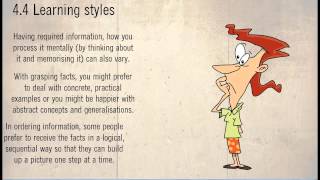Sensory Learning Styles
BTEC National Level 3 in IT ( Learning styles)
4.4 Learning styles
Learning styles vary from one person to the next and no two people learn in the same way. However, studies of groups of individuals and learning styles has resulted in terms being coined to describe different types of learners, such as; active/reflective, sensory/intuitive, visual/verbal, sequential/global.
• Active learners enjoy working in groups and like to try various solution to problems in order to find out what works. They prefer to handle objects and to do physical experiments. Reflective learners prefer to figure out a problem on their own. They think things through, evaluate the various options and learn by analysis.
• Sensory learners look for facts first and prefer concrete, practical and procedural information. Intuitive learners look for meaning and prefer conceptual, innovative and theoretical information.
• Visual learners understand drawings (for example a spider diagram) that represents information. Verbal learners like to hear or read information and understand best explanation that use words.
• Sequential learners need information presented in a linear and orderly manner. They piece together the details to understand the bigger picture. Global learners see the bigger picture first then fill in the details systematically. This is called holistic approach to learning.
A number of models have been developed to describe how people study, how they perceive information, how they process information and how they organise and present what they have learned.
The perception stage relies on:
• Sight (visual cues)
• Hearing (auditory cues)
• Other sensations, including touch, temperature and movement (kinaesthetic cues)
Each of these three types of cues (visual, auditory and kinaesthetic) appeals to some people, but not to others, so the way in which information is presented can affect how people perceive it.
• An auditory learner is most comfortable absorbing information that they have heard or discussed.
• A kinaesthetic learner prefers to learn through practical classes and hands on activities, rather than reading books and listening to lectures.
Most people can learn using a mixture of visual, auditory and kinaesthetic cues.
Having required information, how you process it mentally (by thinking about it and memorising it) can also vary. With grasping facts, you might prefer to deal with concrete, practical examples or you might be happier with abstract concepts and generalisations.
In ordering information, some people prefer to receive the facts in a logical, sequential way so that they can build up a picture one step at a time. Others prefer an overview straightaway, so they can grasp the bigger picture first then focus on the details. Some people engage with the information they have gathered by experimentation, while others prefer to let things sink in through reflective observation.
In organising what you know, you may adopt a holistic overview or engage in detailed and logical analysis. When presenting information to share with others, you might tend to give verbal explanations, while someone else might use images.
Identification of preferred style
A number of quiz-type analyses have been devised to help people to identify their preferred learning style. Your answers to a number of seemingly simple questions build up a profile of you and you can then be given feedback as to what learning styles suit you best.
Knowing your own preferred learning style
Tutors are trained to recognise learning styles and should present information to their classes in a variety of ways so that all learners benefit, regardless of their preferred learning style. However, if you find it difficult to grasp a subject, or find a lesson boring, you might need to adapt your way of listening or note taking as to make the best of the lesson. For example, if your tutor presents you with a handout that find it hard to understand, try and transferring the facts into tubular format or a spider diagram, or present the data in some other way that makes it clearer to you.
The onus is on you to make the most of whatever your tutor presents, but giving feedback to the tutor may help them too. Ask questions if anything is not clear. Offer the tutor your version of the data – they may suggest giving a copy of what you have produced to other learners. Similarly, you might learn from others how to take notes or represent the information they get from the tutor.
Understanding others’ preferred learning style
Because each individual has his or her own preferred learning style, the way in which a team of people learns can be quite complex. Presented with a brief, such as an A4 sheet of written instructions, some of the team will quickly grasp the facts of the problem to be solved. Others will need it explained differently, perhaps by using a diagram or talking it through.
